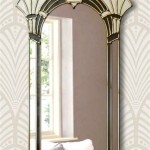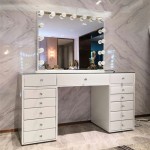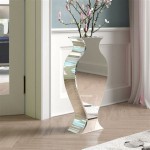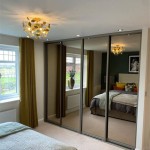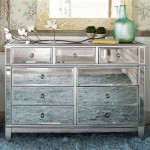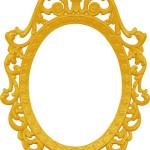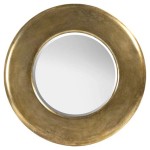Mirrors for Home
Mirrors serve a dual purpose in home décor. They enhance the aesthetic appeal of a room while providing practical functionality. From creating an illusion of space to reflecting light and serving as a quick check before heading out the door, mirrors play a significant role in the overall ambiance and utility of a home.
A wide array of mirror styles caters to diverse tastes and interior design schemes. These range from ornate, antique-inspired pieces to sleek, minimalist designs. Frame materials vary widely, including wood, metal, resin, and even bamboo, offering options to complement any décor. Further customization is possible through various shapes and sizes, from small, circular vanity mirrors to large, rectangular statement pieces.
The placement of a mirror significantly impacts its effect. Strategically positioned mirrors can make a small room appear larger by reflecting light and creating a sense of depth. Placing a mirror opposite a window amplifies natural light, brightening the space and reducing the need for artificial illumination. Mirrors also serve as attractive focal points, especially when used above fireplaces or consoles.
Different rooms benefit from specific types of mirrors. Bathrooms typically utilize vanity mirrors for grooming purposes. These often incorporate features like integrated lighting and magnification. Entryways benefit from wall-mounted mirrors, allowing for a last-minute appearance check before leaving the house. Living rooms and dining rooms can accommodate larger, decorative mirrors that contribute to the overall aesthetic of the space.
Beyond their practical functionality, mirrors play a crucial role in interior design. They can be used to enhance the style of a room. For instance, a large, ornate mirror can add a touch of classic elegance to a traditional living room. A minimalist, frameless mirror can complement a modern or contemporary space. The reflective surface of a mirror can also be used to highlight other decorative elements in the room, such as artwork or plants.
Selecting the right mirror involves considering several factors. The size of the room and the available wall space are primary considerations. The style of the room’s existing décor should also influence the choice of mirror frame and shape. The purpose of the mirror should also be taken into account. Is it primarily for practical use, like a bathroom vanity mirror, or is it intended as a decorative statement piece?
Proper installation is essential for both safety and aesthetics. Wall-mounted mirrors require secure anchoring to prevent accidents. The height of the mirror should be considered based on its intended use and the height of the individuals using it. For larger or heavier mirrors, professional installation is recommended.
Maintaining the clarity and reflectivity of mirrors requires regular cleaning. Using a glass cleaner and a soft cloth can effectively remove smudges and dust. Avoiding harsh chemicals and abrasive materials is crucial to preventing damage to the mirror surface. Regular cleaning also helps maintain the aesthetic appeal of the mirror and the room as a whole.
The versatility of mirrors extends beyond their use in residential settings. Commercial spaces, such as retail stores and restaurants, frequently utilize mirrors to create specific atmospheres. In retail settings, mirrors are essential for fitting rooms and displays. Restaurants might use mirrored walls to create an illusion of spaciousness. The strategic placement of mirrors can significantly influence the perception of a space.
The evolution of mirror design reflects changing trends in interior design. While traditional styles remain popular, contemporary designs incorporating innovative materials and shapes are gaining traction. Backlit mirrors, for instance, are becoming increasingly common, offering both functionality and aesthetic appeal. Smart mirrors, incorporating technology for displaying information and entertainment, represent a further advancement in mirror design.
The reflective properties of mirrors have fascinated civilizations for centuries. From their early use in polished metal surfaces to the development of modern glass mirrors, the technology behind their production has evolved considerably. Today's mirrors offer a combination of functionality and artistic expression, serving as both practical tools and decorative elements within the home.
The cost of mirrors varies significantly based on size, materials, and design. Simple, frameless mirrors are generally more affordable, while ornate, antique-style mirrors can command higher prices. The quality of the glass and the craftsmanship of the frame contribute to the overall cost. Consumers can find mirrors to suit a range of budgets, from budget-friendly options to high-end, handcrafted pieces.
Mirrors offer a timeless and versatile solution for enhancing the aesthetics and functionality of any home. Their ability to reflect light, create illusions of space, and serve as decorative elements makes them an essential component of interior design. The wide array of styles, sizes, and materials available ensures that there is a mirror to suit every taste and décor scheme.

7 Innovative Ways To Introduce Mirrors Your Home

Mirrors At Home

14 Stunning Statement Mirrors And How To Use Them At Home Design

Home Decorators Collection Large Arched Black Classic Accent Mirror 39 In H X 26 W H5 Mh 724 The Depot

Arranging Lights And Mirrors For A Clutter Free Home In Budget Lifestyle Decor English Manorama

Modern Wall Mirrors Redefining Contemporary Home Decor Mirrorwalla

6 Ways To Use Mirrors Make Your Home Feel Bigger And Brighter

Wall Mirror Design Ideas For Your Home Cafe

Home Decorators Collection Medium Arched Black Classic Accent Mirror 35 In H X 24 W H5 Mh 255 The Depot

Bryn Wall Mirror 122x82 Cm Home Centre Oman

